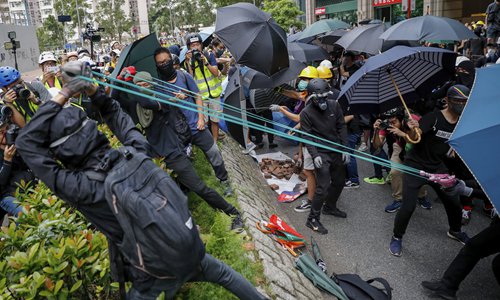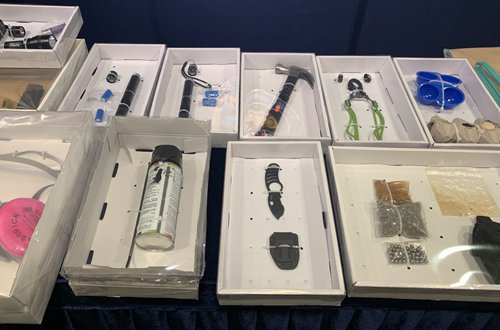HOME >> CHINA,SPECIAL-COVERAGE
Hong Kong riots have 'signs of terrorism': official
By Chen Qingqing and Wang Wenwen in Hong Kong Source:Global Times Published: 2019/8/13 0:23:39
Police use ‘minimum force’ in dispersal

Protesters use a homemade sling shot to shoot bricks to the Tseung Kwan O police station in Hong Kong on Sunday. Photo: AP
Hong Kong police vowed on Monday to push efforts to fight illegal protesters who use more dangerous weapons and endanger the public, with the mobs' violent actions have shown "signs of terrorism."
Following days of guerrilla-style and flash mob protests in the city, central government officials and Hong Kong police have strongly condemned escalating violence across the city, disrupting public order and putting ordinary Hongkongers in danger.
The Hong Kong and Macao Affairs Office of the State Council also said that attacking police officers with dangerous weapons is a crime, which showed signs of terrorism, and such crimes must be dealt with resolutely and in accordance with the law, according to a press briefing on Monday.
This past weekend, illegal protesters besieged several police stations in various districts, including Kwai Chung, Tsim Sha Tsui, Sham Shui Po, using bricks, stones, steel balls, daggers, hammers and other lethal weapons to attack police offers. They also threw gasoline bombs in Sham Shui Po and Tsim Sha Tsui, injuring police officers.
"No matter how hard protesters disguise violence, they can't get away with the nature of the violence," Tang Ping-keung, deputy commissioner of police (operations), said at a press conference in the police headquarters on Monday.
Compared to previous dispersal work, the Hong Kong police acted in a more efficient way, as law enforcement was much faster than before, and police officers, particularly the Special Tactical Squad - an elite paramilitary task force of the Hong Kong Police Force - accurately grasped the information about the movements of black-clad protesters assisted by undercover police tactics.
"Because they were illegal assemblies, the protesters violated the law. It's right for the police to use undercover tactics. It's like undercover police cracking down on gangsters," Joe Chan Cho-kwong, former chairman of the Junior Police Officers' Association, told the Global Times on Monday.
The police conducted dispersal work with minimum force, which was also strictly in line with the law, officials said.
The police have used undercover officers in accordance with the intelligence acquired, a senior police officer said.
"Undercover officers will not trigger any unrest or engage in any unlawful actions," Tang said.

Weapons seized by police from illegal protesters on Sunday, including a dagger and hammer, are shown at the headquarters of the Hong Kong police on Monday. Photo: Chen Qingqing/GT
Signs of terrorism
Speaking at a press conference on Monday, Hong Kong Secretary for Security John Lee said the police are trying to carry out actions that cause the minimum degree of injuries, and that only non-lethal weapons have been used.
"That is why they have to use tear gas and that is to maintain a safe distance so that there is no large-scale confrontation, and the amount of force they use are non-lethal weapons," said Lee.
Lee said there is a particular group of people carrying out serious violent acts, such as throwing petrol bombs.
"This is sowing the seed of terror, which I think the Police must deal with."
The police also said 149 rioters armed with offensive weapons such as petrol bombs were arrested from Friday to Sunday. And thanks to accurate information, it also arrested some of the core members of recent illegal assemblies.
Illegal protesters are now using lethal weapons, including explosives, bows and arrows, grenade launchers to shoot projectiles at the police. They even hurled petrol bombs at police officers, causing one police officer's legs seriously burned.
A former police officer, who preferred not to be named, told the Global Times that some protesters were carrying folding military knives.
Yang Guang, spokesperson of the office, slammed rioters for undermining the city's "rule of law and social order."
A Beijing-based law expert told the Global Times on condition of anonymity that "Violent protests matter to public security from the angle of law, while terrorism touches on national security.
"If the situation spirals to the level of terrorism, the central government has the responsibility to urge the Hong Kong government to secure both public security and national security," the expert said.
The Liaison Office of the Central People's Government in Hong Kong also condemned the violence.
"Such heinous terrorist actions will never be tolerated in any part of the world. If such actions are allowed to spread, Hong Kong will slide into a bottomless pit," the office said in an official statement issued on Monday.
At recent illegal assemblies, protesters ignored police warnings and constantly provoked the police through insults, dog barks, and flashing laser pens at police officers. But the police force responded to such illegal activities in a very restrained and professional way.
Western media and some local press blamed Hong Kong police for using tear gas on Sunday night inside the Kwai Fong station, where another clash between violent protesters and the police occurred.
The police on Monday defended their actions and confirmed that they only fired one tear gas canister.
Kong Wing-cheung, senior superintendent at the Police Public Relations Branch, said at the press conference that it was for the sake of public security as the violent protesters used bullet forks and steel balls against the police, which may hurt people inside the subway station as well.
"We will use tear gas when violence needs to be stopped, and we do so after considering the environment and the people involved," said Mak Chin-ho, assistant commissioner of police (operations).
Newspaper headline: ‘Terror’ signs in HK riots
Posted in: HK/MACAO/TAIWAN,FOCUS NEWS